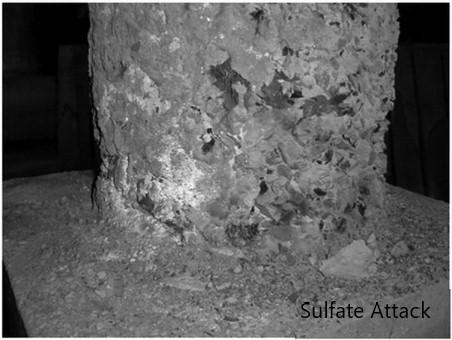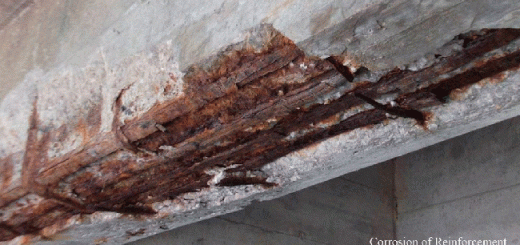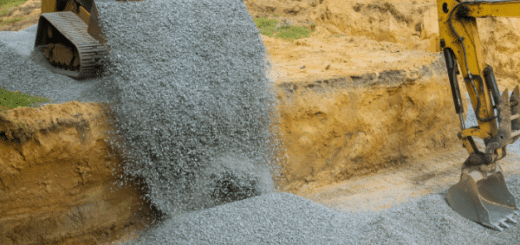Sulfate Attack on Concrete Designer’s Perspective
Reinforced concrete structures are widely used in construction due to their strength and durability. However, these structures are not immune to various forms of deterioration, and one significant concern is sulfate attack. In this article, we will delve into the world of sulfate attack on reinforced concrete structures, with a particular focus on the structural design aspects.
What is Sulfate Attack
Sulfate attack is a chemical reaction that occurs when sulfates in various forms come into contact with concrete. Sulfates can be present in soil, groundwater, or even in construction materials. When these sulfates react with the components of concrete, it can lead to structural damage over time.
Types of Sulfate Attack
There are two primary types of sulfate attack: external sulfate attack and internal sulfate attack.
- External Sulfate Attack
External sulfate attack occurs when sulfates in the environment, such as in soil or groundwater, penetrate the concrete from the outside. This can happen in areas with high sulfate concentrations in the soil.
- Internal Sulfate Attack
Internal sulfate attack, on the other hand, occurs due to the presence of sulfates within the concrete mix itself. This can happen if sulfate-rich aggregates or contaminated water are used during the construction process.
Effects of Sulfate Attack on Concrete
Sulfate attack can have several detrimental effects on concrete, including:
- Expansion and Cracking: Sulfate attack can cause the concrete to expand, leading to cracking and loss of structural integrity.
- Loss of Strength: The reaction between sulfates and concrete components can weaken the material, reducing its load-bearing capacity.
- Surface Deterioration: Sulfate attack can result in surface scaling and spalling, making the concrete unsightly and less durable.
Chemical Reactions in Sulfate Attack
The chemical reactions involved in sulfate attack are complex but can be summarized as follows:
- Sulfate Ions Reaction: Sulfate ions (SO42-) present in the sulfate source react with the calcium ions (Ca2+) in the hydrated cement compounds, forming calcium sulfate compounds. These compounds take up more space than the original calcium ions, leading to expansion and cracking.
- Ettringite Formation: In the presence of aluminum ions (Al^3+), sulfate ions can react to form a compound called ettringite (3CaO·Al2O3·3CaSO4·32H2O). Ettringite has a larger volume than the reactants, contributing to concrete expansion.
- C-S-H Gel Depletion: Sulfate attack can also disrupt the calcium-silicate-hydrate (C-S-H) gel, which is responsible for the concrete’s strength. This gel can be attacked and depleted by sulfate ions.
Understanding these chemical reactions is essential in devising effective strategies to prevent sulfate attack and protect concrete structures.
Detecting Sulfate Attack
Detecting sulfate attack in its early stages is crucial for mitigating potential structural damage. While some signs are readily visible, a comprehensive assessment may require the expertise of a structural engineer or materials specialist. Here are various methods and indicators to help detect sulfate attack:
- Visual Inspection: A thorough visual inspection of the concrete structure can reveal initial signs of sulfate attack. Look for:
- Cracking: Cracks on the concrete surface, especially those in irregular patterns, can be an early indicator.
- Efflorescence: White, powdery deposits on the surface, caused by sulfate salts, are a common visual cue.
- Surface Deterioration: Examine the concrete for scaling, spalling, or surface discoloration, as these may indicate sulfate-related damage.
- Core Sampling: Core sampling involves drilling into the concrete and extracting cylindrical samples. These samples can then be analyzed for sulfate content and the presence of sulfate-related compounds. Core sampling provides a more accurate assessment of internal damage.
- Ultrasonic Testing: Ultrasonic pulse velocity (UPV) testing can determine concrete’s integrity by measuring the speed of sound waves passing through it. Areas with higher levels of sulfate-induced damage may exhibit slower wave velocities. However, this test along cannot be used to penetration of the sulfate into the concrete, but the condition of the concrete would be assessed.
- Chemical Analysis: Laboratory testing of concrete samples can identify the specific sulfate compounds present and their concentrations. This information helps assess the severity of sulfate attack.
- Electrical Resistivity Testing: This non-destructive test measures the electrical resistivity of concrete. Elevated resistivity values can suggest sulfate attack as it often increases concrete resistivity.
- pH Monitoring: Monitoring the pH levels of concrete pore solutions over time can help detect changes indicative of sulfate attack. A significant decrease in pH may signal ongoing sulfate reactions.
- Infrared Thermography: Infrared thermography can identify areas of differential temperature, potentially indicating moisture or chemical changes associated with sulfate attack.
- Microscopic Examination: Microscopic analysis of concrete specimens can reveal the formation of sulfate-related crystals, such as ettringite, within the concrete’s microstructure. Further it should be noted that the formation of crystals like ettringite could be due to the other reasons such as rise of the concrete temperature beyond the acceptable levels in the hydration process. Commonly known as delayed ettringite formation.
- Data Logging: Continuous monitoring of environmental conditions, such as temperature, humidity, and sulfate concentration in soil or groundwater, can provide early warnings of potential sulfate attack risks.
It’s important to note that early detection is essential for effective remediation. Once sulfate attack progresses to an advanced stage, it becomes more challenging and costly to repair.
Therefore, regular inspections, coupled with appropriate testing methods, can help ensure the long-term durability of reinforced concrete structures in sulfate-rich environments. When in doubt, consult with experienced professionals who specialize in concrete analysis and structural evaluation.
Preventive Measures
To mitigate the risks of sulfate attack, several preventive measures can be taken:
- Proper Material Selection: Choosing sulfate-resistant materials, such as low-alkali cement and sulfate-resistant aggregates, is essential.
- Water Quality: Ensuring that the water used in the concrete mix is sulfate-free is crucial.
- Construction Practices: Implementing good construction practices, such as proper curing and minimizing exposure to sulfates, can help prevent sulfate attack.
- Desing consideration such as adequate cover to the reinforcement
Sulfate-Resistant Materials
Incorporating sulfate-resistant materials in concrete mixes is a fundamental strategy for safeguarding concrete structures against sulfate attack. These materials are specially designed to resist the corrosive effects of sulfates, ensuring the longevity and durability of the structure. Here are some key sulfate-resistant materials and considerations:
Sulfate-Resistant Cement:
The primary ingredient in concrete is cement, and using sulfate-resistant cement is the foundation of sulfate attack prevention. This type of cement contains a lower percentage of tricalcium aluminate (C3A), which is highly reactive with sulfates.
It helps mitigate the chemical reactions that lead to expansion and cracking. Sulfate-resistant cements are designated code of practices. Those types of cements or cement combinations shall be used for the construction.
Sulfate-Resistant Aggregates:
Aggregates make up a significant portion of concrete, and using sulfate-resistant aggregates is equally crucial.
These aggregates have low reactivity with sulfates and do not contribute to the expansion of the concrete. It’s important to source aggregates that have been tested and certified as sulfate-resistant to ensure their effectiveness.
Low-Alkali Cement:
Alkalis, such as sodium and potassium, can exacerbate sulfate attack. Low-alkali cement contains reduced alkali content, making it more resistant to the effects of sulfates. This type of cement is suitable for use in areas where sulfate exposure is a concern.
Fly Ash and Slag:
Supplementary cementitious materials like fly ash and slag can enhance sulfate resistance. These materials react with sulfates to form stable compounds, reducing the risk of expansion and cracking. They also contribute to improved long-term durability.
Chemical Admixtures:
Sulfate-resistant chemical admixtures can be added to the concrete mix to further enhance sulfate resistance.
These admixtures work by modifying the hydration process and reducing the permeability of the concrete. Common additives include calcium nitrate and calcium thiocyanate.
Sealers and Coatings:
In addition to using sulfate-resistant materials in the mix, applying sealers and coatings to the concrete surface can provide an extra layer of protection.
These products create a barrier that limits the penetration of sulfates into the concrete.
Polymer-Modified Concrete:
Polymer-modified concrete incorporates polymers into the mix, improving the concrete’s resistance to various forms of degradation, including sulfate attack. These polymers enhance the cohesion and impermeability of the concrete.
Fiber-Reinforced Concrete:
Adding fibers, such as polypropylene or steel fibers, to the concrete mix can enhance its resistance to cracking caused by sulfate attack. These fibers improve the concrete’s tensile strength and help control shrinkage cracks.
Quality Control and Testing:
To ensure the effectiveness of sulfate-resistant materials, quality control measures and testing protocols should be in place during concrete production. Regular laboratory testing and concrete mix design adjustments can help optimize sulfate resistance.
Proper Construction Practices:
Beyond material selection, implementing proper construction practices is essential. Ensuring adequate curing, proper concrete placement, and minimizing exposure to sulfate-rich environments during and after construction are critical aspects of preventing sulfate attack.
By combining these sulfate-resistant materials and practices, concrete structures can withstand sulfate exposure and maintain their structural integrity over time. It’s important for engineers and builders to collaborate closely, considering both material selection and construction techniques to create durable concrete structures in sulfate-rich environments.
Structural Design Considerations
Structural design plays a pivotal role in safeguarding reinforced concrete structures from sulfate attack. Here are some critical considerations:
- Reinforcement Placement: Proper placement of reinforcement bars and ensuring adequate concrete cover can prevent sulfate penetration.
- Durability Design: Structural engineers should incorporate durability design principles, accounting for sulfate exposure, in their calculations.
- Maintenance Provisions: Including maintenance provisions in the design allows for regular inspections and repairs to address sulfate attack as it occurs.
FAQs
01. Is sulfate attack a common problem in construction?
Sulfate attack can be a concern in areas with high sulfate concentrations, especially near coastal regions.
02. Can sulfate attack be completely prevented?
While complete prevention may be challenging, the use of sulfate-resistant materials and proper design can significantly reduce the risk.
03. How do I detect sulfate attack in an existing structure?
Look for signs like cracking, efflorescence, and surface deterioration. Consulting a structural engineer is advisable for a thorough assessment.
04. What are some sulfate-resistant materials for concrete?
Sulfate-resistant cements and aggregates are commonly used. Consult with a materials expert for specific recommendations.
05 Is sulfate attack reversible?
Once concrete is damaged by sulfate attack, it is challenging to reverse the effects. Prevention and maintenance are key.




